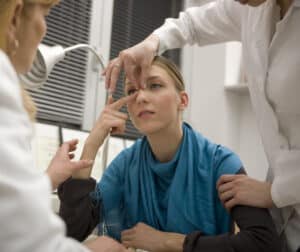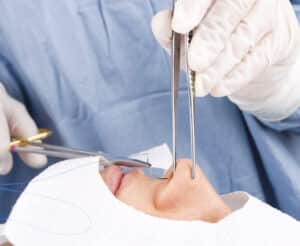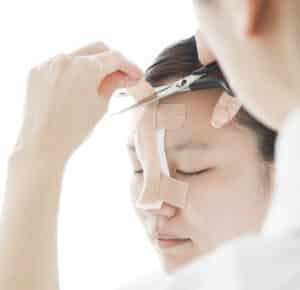What is Rhinoplasty?
Rhinoplasty, also known as a “nose job” is the procedure that is used to reconstruct the shaping of the nose. It can help make your nose more proportional to the rest of your facial features as well as improve a patient’s breathing if they have issues like a deviated septum. Dr. Alfonso Barrera can help you achieve your goals and boost your confidence with this nose correction procedure.
Rhinoplasty Candidates

- your nose appears too large for your face
- there is a bump on the nasal bridge when viewed in profile
- your nose seems too wide when viewed from the front
- the nasal tip droops or plunges
- the tip is thickened or enlarged
- your nostrils are excessively flared
- your nose is off-center or crooked
- previous injury has made your nose asymmetrical
It is important that you have a clear idea of how you would like your nose to look and, at the same time, realize that there are limitations to the procedure. Patients with sufficient physical and emotional maturity who undergo rhinoplasty because they want to enhance their self-image are usually very satisfied with their decision.
Plastic surgeons usually recommend that patients wait until they are at least 14 or 15, and possibly older for boys, before undergoing rhinoplasty. This is because the nose may not be fully developed at a younger age. If you are a teen, Dr. Barrera will want to be certain that you have thought carefully about surgery and that the desire to change your appearance is based on your own feelings rather than those of your parents or friends.
Rhinoplasty Risks
Fortunately, significant complications from rhinoplasty are infrequent. Every year, many thousands of people have their noses reshaped, experience no major problems and are pleased with the results. Anyone considering surgery, however, should be aware of both the benefits and risks.
How Will Dr. Barrera Evaluate Me for Nose Surgery?
You should come to the consultation prepared to discuss your medical history. This will include information about any medical conditions you may have, medical treatments you have received, previous surgeries including repair of nasal injuries, and medications that you currently take. Dr. Barrera may also ask whether you have difficulty breathing through your nose, suffer from allergies that may cause nasal stuffiness, or are a chronic user of a nasal spray. It is important for you to provide complete information.
In evaluating you for rhinoplasty, Dr. Barrera will conduct a routine and painless examination of your internal nasal structures. Your skin quality, as well as the size and shape of your nose and its relationship to your other facial features, will be carefully studied. In some instances, your plastic surgeon may recommend surgery of your chin, making it either more or less prominent, to improve facial balance. This procedure can be done at the same time as your rhinoplasty.
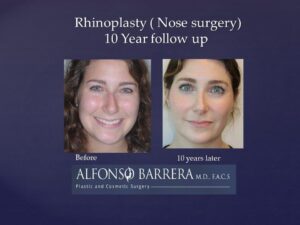
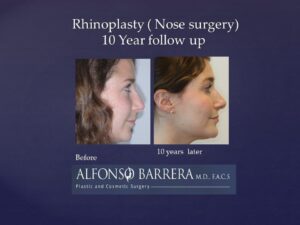

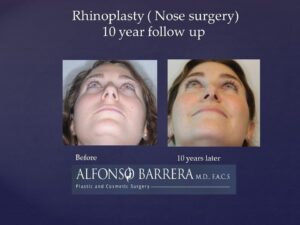
View Our Rhinoplasty – Nose Surgery Gallery →
Rhinoplasty After Your Personal Consultation
During the initial consultation, you may be asked to look in a mirror and point out exactly what you would like to see improved. This will help your plastic surgeon to understand your expectations and determine whether they can realistically be achieved.
Your Nose Surgery Experience
The goal of Dr. Barrera and his staff is to make your surgical experience as easy and comfortable for you as possible. I understand that every surgical procedure has risks, but how will I learn more so that I can make an informed decision?
Depending on the surgical technique used, a splint may be placed on the bridge of the nose for the purpose of holding the tissues in place until they have stabilized. The subject of risks and potential complications of surgery is best discussed on a personal basis between you and your surgeon, or with a staff member in Dr. Barrera’s office.
Some of the potential complications that may be discussed with you include hematoma (an accumulation of blood under the skin that may require removal), infection, and reactions to anesthesia. Numbness of the skin following rhinoplasty may occur but is usually temporary. Occasionally, if the surgical outcome needs further improvement, additional surgery may be necessary.
You can help minimize certain risks by following the advice and instructions of your plastic surgeon, both before and after your surgery.
How Should I Prepare For My Nose Job Surgery?
If you are a smoker, you will be asked to stop smoking well in advance of surgery. Aspirin and certain anti-inflammatory drugs can cause increased bleeding, so you should avoid taking these medications for a period of time before surgery. Dr. Barrera will provide you with additional preoperative instructions.
If your rhinoplasty will be performed on an outpatient basis, be sure to arrange for someone to drive you home after surgery and to stay with you at least the first night following surgery.
What Will The Day Of Surgery Be Like?
Dr. Barrera performs all aesthetic surgery procedures including rhinoplasty surgery at his Accredited Ambulatory Surgical Facility (AAAASF) under IV sedation and local anesthesia, without the need for general anesthesia (painless during the procedure and minimal pain afterward). This provides added safety and faster recovery. Most patients are able to go home within an hour from the end of the procedure with minimal discomfort.
Depending on the surgical technique used, a splint may have been placed on the bridge of your nose for the purpose of holding the tissues in place until they have stabilized. The splint will protect your nose while you sleep and shield it from accidental bumps. Frequently, you may also have a small triangular bandage beneath the tip of your nose. Packing or soft internal splints are sometimes used inside the nostrils, especially if work has been done to improve your breathing.
You probably will be permitted to go home after a few hours, although some patients may stay overnight in the hospital or surgical facility.
How Long Does a Nose Job Procedure Take?
Usually, the procedure takes around 1-2 hours.
What Type Of Anesthesia Is Best For Rhinoplasty?
Generally, I do all my Rhinoplasties ( Nose surgeries ) under a twilight IV Sedation and Local anesthesia, There is No pain at all during surgery and little to no pain afterward. It is extremely rare to have nausea or vomiting after surgery, which allows a faster recovery to go home or to a local hotel the same day soon after the procedure. Only if extensive septal or turbinate surgery is needed, then I would use general anesthesia.
How Is Dr. Barrera Able to Reshape My Nose?
Alterations may be made to increase or decrease the nasal bridge, reduce the size or width of the nose, narrow the nostrils, change the angle between the nose and upper lip, or reshape the tip.
Small wedges of skin, as shown, are removed to narrow the base of the nose or reduce the width of the nostrils.
The surgical techniques employed will depend primarily on the goals established by you and Dr. Barrera. In many instances, all of the incisions will be placed inside your nose, where they will not be visible. If the base of the nose is narrowed or the nostrils reduced, small wedges of skin at the base of the nostrils will be removed. Incisions are hidden in the natural crease where the nostril joins the cheek.
Sometimes a very short incision is made across the vertical strip of tissue that separates the nostrils, called the columella. This technique is called an “open rhinoplasty.” Whatever incisions are used to reshape your nose, they will ultimately be very inconspicuous.
What Procedures Can Be Performed in Conjunction with a Nose Job?
Rhinoplasty is sometimes performed in conjunction with a facelift or other rejuvenate surgery to correct aging changes of the nose such as a drooping tip.
Sometimes certain breathing problems related to the internal nasal structures can be corrected at the same time as nose reshaping is performed. Your plastic surgeon will be able to help you determine whether these structures should be modified along with reshaping your nose.
Dr. Barrera can provide further information if you have an interest in any of these additional procedures.
Where Are the Rhinoplasty Incisions Placed?
Incisions are placed inside the nose to provide access to the cartilage (blue shaded area) and brown (light brown shaded area) that form the nasal framework.
Through the small incisions described previously, work is done on the cartilage and bone that form the framework of your nose. Sometimes, the position of certain bones may need to be altered slightly in order to make your nose look narrower and straighter. If your nose needs to be built up in some areas, this can be done using nasal cartilage, or perhaps bone or cartilage from another site. The skin and soft tissues then redrape themselves over this new “scaffolding.”
Types of Rhinoplasty
Closed Rhinoplasty
Closed rhinoplasty is my preferred technique because the results are excellent and you avoid the incision across the “collumela” (the central base of the nose) the healing and recovery are faster. Many surgeons do not do closed rhinoplasty because it is technically more difficult and requires a lot more experience.
Open Rhinoplasty
In select and challenging cases may be needed to achieve the end result that is not possible with a closed technique. For example, a deformed nose from a previous surgery, or deformity due to a birth defect like cleft lip and palate. Or just one that is plain complicated.
What Our Patients Have to Say
“I have seen Dr. Barrera and his staff 3 times over nearly 20 years. I would not go anywhere else. The staff is exceptional and Dr. Barrera is highly skilled. The post surgery follow-up is outstanding by both the staff and Dr. Barrera. They over-deliver which is rare these days.” -Timothy T.
Want to Read More Patient Reviews? Click here!
How Will I Look Initially Following My Nose Job?
It is important to realize that the amount of time it takes for recovery varies greatly among individuals.
The first couple of days after surgery, you should restrict your activities and sleep with your head elevated. This will help to minimize swelling and reduce the possibility of minor bleeding, which is not uncommon. Remember, you must not take aspirin or certain anti-flammatory medications.
Generally, bruising around the eyes and cheeks is most apparent during the first three days following surgery. Most discoloration will disappear within a week. A few days after surgery, you can begin to use makeup as a concealer, if desired. Noticeable swelling may last for several weeks. Minor residual swelling, most frequently affecting the nasal tip, may continue for many months, but generally, this should not be apparent to others. If packing was used, it will either dissolve by itself or be removed three to seven days after surgery. Stitches may also be removed at that time. You may need to continue wearing the nasal splint for up to a week, during which time you should avoid getting it wet.
Rhinoplasty Results
The goal of rhinoplasty is a nose that looks natural and blends harmoniously with your other facial features.
Since the healing process is gradual, you should expect to wait up to one year to see the final results of your rhinoplasty. You are likely, however, to begin enjoying your new look within weeks of your surgery.
Occasionally, a touch up may be desired to further improve the results. If this is the case, the additional procedure is usually less extensive than the original operation.
Rhinoplasty – Nose Surgery Before and After Photos
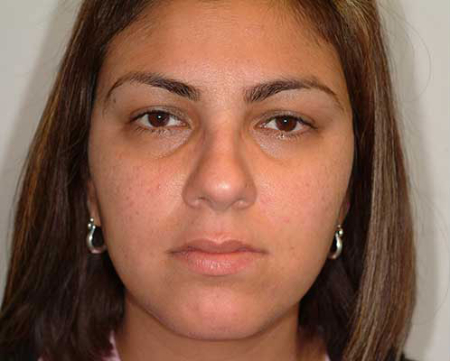
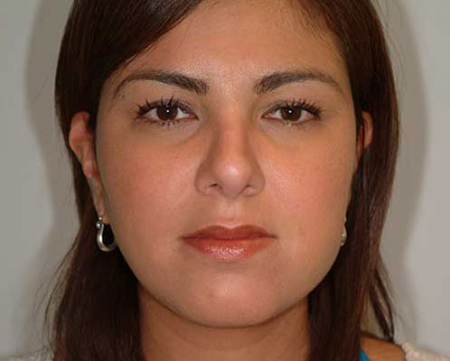
View Our Rhinoplasty – Nose Surgery Gallery →
When Can I Resume My Normal Activities?
Straining, bending and lifting should be avoided during the early postoperative period. In many instances, you may be able to return to work within a week or ten days after surgery. Most normal activities including exercise can usually be resumed within three weeks.
It will be a few months before you can expose your reshaped nose to direct sunlight. Your nose will be sensitive during this time, and you must be conscientious about using a sun block to protect your skin. If the bones of your nose were altered, it may be a number of weeks before you can wear glasses without special support such as tape.
How Long Will the Results Last?
In most instances, the results of rhinoplasty are permanent, except for possible changes associated with the normal aging process.
Schedule a Consultation
Unhappy with the appearance of your nose? Contact us at (713) 468-5200 to schedule your Nose Surgery consultation with Alfonso Barrera, MD today! Our practice is proud to serve Houston, TX, and the surrounding areas.

